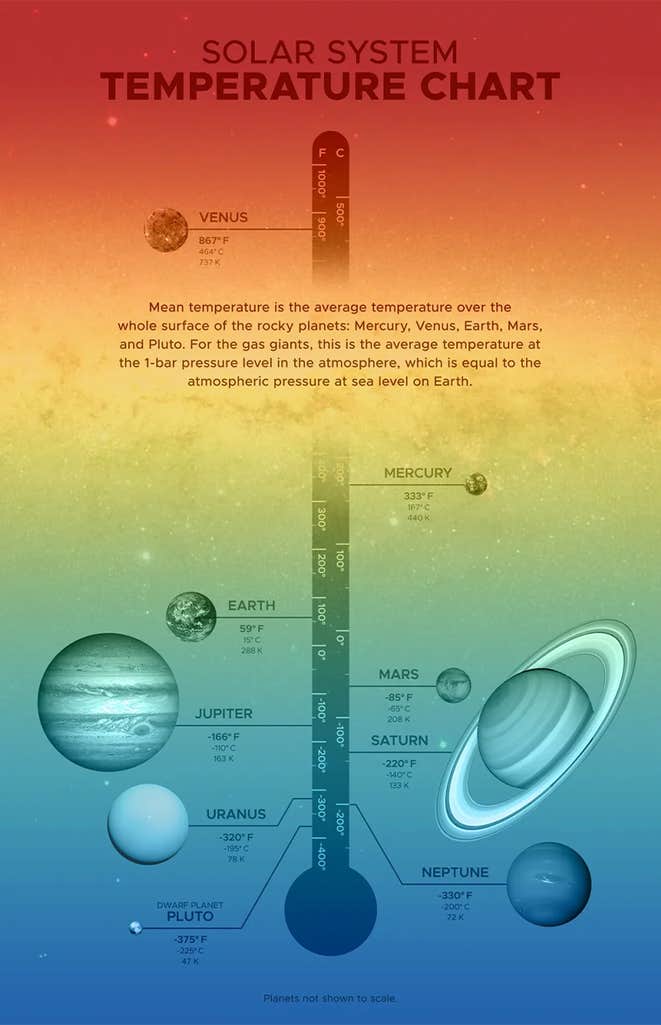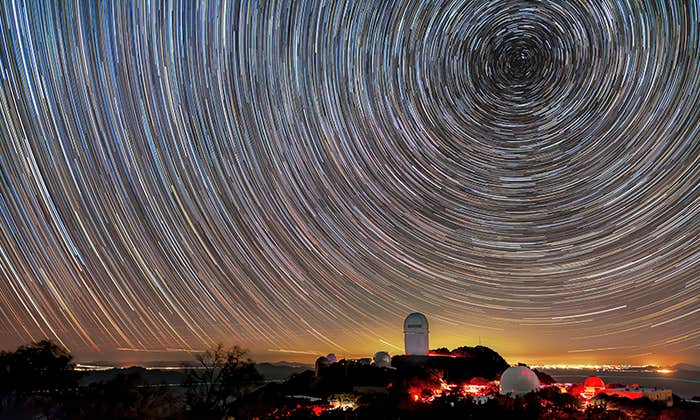Hold a grain of sand up to the night sky at arm’s length. There are thousands of galaxies in that miniscule fraction of the heavens. Galaxies like ours hold hundreds of billions of stars—a good portion of which host planets. And a number of these are in the “habitable zone,” that just-right distance from a star where the temperature might fall between zero and 100 degrees Celsius, the right conditions for liquid water. Perhaps for life, too.
But the habitable zone is often misunderstood. A planet within the habitable zone may not host water, or be even remotely habitable. There are countless other factors at play—some of them buried deep below the surface. “The habitable zone is a useful concept for astronomers,” says Noah Tuchow, an astronomer at NASA’s Goddard Space Flight Center who studies the effect of the habitable zone on planets. “It’s best thought of as a hypothesis.”
A hard lesson in these odds sits just next door to us, in our solar system.
Venus might have once been very much like Earth.
Venus perches on the edge of the traditional habitable zone around our sun. Yet life—at least as we best understand it—would not enjoy modern-day Venus. It has no water. Its surface temperature is 465 degrees Celsius (870 degrees Fahrenheit), hot enough to melt lead, hotter even than Mercury (which perches nearly twice as close to the sun as Venus). Its surface also has extraordinarily high pressures, equivalent to being about 3,000 feet underwater on Earth (which exerts around 1,300 pounds per square inch). Its atmosphere is so thick that only 3 percent of solar energy reaches the surface.
So, despite its alluring location, Venus does not seem an ideal place to go hunting for easy-to-spot extraterrestrial life forms. But because of its very apparent inhospitability, Venus is an excellent foil in our quest for life in the cosmos. That’s the argument of two planetary scientists behind a recent paper in Nature Astronomy: If scientists can better understand the harsh history of Venus, they will be much better equipped to know where to look—and perhaps more importantly, where not to look—for life elsewhere.
Venus is often referred to as Earth’s sister planet. They are almost identical in size and bulk composition. But their vast differences seem to stem from deeper dynamics than simply distance from the sun.
Michael Way is an astronomer at Goddard and has modeled many potential histories of the planet Venus. There are two main possibilities, he explains. In one, Venus was always a hell-house world. It would have received water from ice-bearing asteroids and comets, just like early Earth, but high temperatures would have prevented this water from condensing. This steam would have remained in the atmosphere over a bubbling magma ocean for up to a few hundred million years. At that point, when the sun became more active, the steam would have broken down into hydrogen and oxygen. The hydrogen would have been lost to space, while the oxygen would have been trapped in the magma.

But there’s another possibility. Venus might have once been very much like Earth, with liquid water and an inviting climate.
“In the other scenario, the magma ocean lifetime is fairly short,” Way says. “The magma ocean cools, and bam! All that steam condenses … and you’re left, more or less, with an aqua planet.” In this possible history, the water condenses before the sun ramps up its activity, leaving the planet with lapping oceans.
But even if Venus was once a world with oceans much like ours, the similarity didn’t last. This might be in part because of its spin.
Venus rotates slowly (and, like Uranus, “backward”). It has the longest day in the solar system, lasting 243 Earth days, which is 18 (Earth) days longer than its year. Rotation makes a tremendous difference in the climate of a planet—for many reasons. When a planet is rotating slowly, it stands to reason that the day- and night-side of the planet may have radically different temperatures depending on which side is facing the sun. Right now, the oppressive atmosphere of Venus equalizes the day and nighttime temperatures of the planet. But if a young Venus had oceans, its long days could have generated weather patterns with dramatic outcomes. For example, clouds on the day-side of Venus could have lingered for so long that they would cool the planet much more than if it was rotating quickly. These clouds would have kept the planet temperate, too, even as the sun became more luminous.
A planet within the “habitable zone” may not be even remotely habitable.
These types of nuanced dynamics, “really opened the doorway in thinking more broadly about the many, many differences between Venus and Earth than just the amount of energy received from the sun,” says Stephen Kane, a planetary astrophysicist at the University of California, Riverside and one of the coauthors of the recent paper praising the usefulness of Venus’ barrenness.
The surface of Venus reveals additional clues about why it is so unlikely to host familiar forms of life. Anna Gulcher, a geophysicist at NASA’s Jet Propulsion Laboratory interested in the tectonic processes on Venus, is working on three upcoming missions to the planet. Present-day Venus does not have plate tectonics—at least, not like what we see on Earth, she explains. Instead of having rigid plates sliding around, colliding with one another, and pulling apart, Venus appears to have what’s called a “squishy lid.” “It basically means you have a one-plate planet, but at certain locations, it’s quite deformable,” says Gulcher.
This “squishy lid” might seem like a passing detail. But the covering has major implications for a planet’s temperature and how it can regulate its atmosphere.
Plate tectonics, the type we see on Earth, helps cool a newly formed planet as heat escapes at plate boundaries. Subducting plates are critical for the carbonate-silicate cycle, sequestering CO2 in the atmosphere deep into the mantle. Without subduction, this greenhouse gas would build up in the atmosphere. And although plate tectonics might not be necessary for life to begin, it may be important for the long-term support of life, allowing the climate of a planet to remain more stable. “Generally people agree that plate tectonics seems to be one of the requirements that the Earth had that made it develop life,” Gulcher says.
Moving plates also hint at the presence of oceans to help lubricate them. Although researchers are unsure about the implications for an ancient Venus.
“There is a bit of a cause-and-effect issue. If it had plate tectonics, did it lose its water and subsequently lose that lubrication mechanism that enabled [plate tectonics]?” asks Kane. “Or did it shut down plate tectonics and it was no longer able to sequester the carbon from the atmosphere, which caused the temperature to rise and then lose its oceans?”
When it comes to searching for life, the past history of a planet is almost as important as its present, as this can help us to narrow down what caused a planet to become inhospitable. Understanding what triggered what will help us understand the history of Venus and its pathway moving from a potentially temperate world to one so unwelcoming to life.
Although Venus does not currently have plate tectonics like we have on Earth, it does have a molten core—and an outlet for its magma: volcanoes. An estimated 85,000 of them, some of which are more than 60 miles across. “In the case of Venus, you actually have volcanoes that rival the size of the ones on Mars, but mainly no one talks about them just because Mars has a better publicity team,” jokes Paul Byrne, an Earth and planetary scientist at Washington University in St. Louis and the other coauthor of the new paper.
Venus’ oceans would have boiled away. Plate tectonics may have come to a halt.
The planet’s single “squishy lid” means plates are not moving over hotspots, so volcanoes have a chance to grow to supermassive sizes. Giant plumes rise through the mantle of Venus and press against the crust. They create odd circular structures named coronae. Sometimes these plumes can be huge. These multi-million cubic mile magma bubbles can form “traps” and trigger large-scale volcanism and further heating.
Volcanism is often closely tied to a planet’s climate, heating and dumping massive amounts of greenhouse gasses into the atmosphere. Large-scale volcanism can quickly and dramatically change the climate. In the immediate term, ash and dust can block sunlight, cooling the planet. In the long term, however, massive amounts of carbon dioxide released in volcanism can trigger planetary warming. We’ve seen similar events triggered from traps on Earth—the Deccan and Siberian traps for example. These events may have led to mass extinctions.
If, Way says, more than one of these events happened at the same time on Venus, they could have changed the planet’s geology and resulting climate. Massive amounts of carbon dioxide would have been dumped into the atmosphere, increasing the temperature of the planet. The oceans would have boiled away. Plate tectonics may have come to a halt, and with no way to sequester carbon dioxide and steam, a runaway greenhouse effect might have been triggered. Steam would have broken down, and leftover oxygen could have been locked away in magma, leaving Venus to be the thoroughly uninhabitable “habitable zone” neighbor we have today.
In consolation for Venus’ slow, lifeless spin through the cosmos, it provides at least one convincing model for where we might not want to go hunting for life. In looking for planets around other stars, planetary history, plate tectonics, rotation rate, and volcanism will all work together to further narrow down appealing candidate worlds within the very broad “habitable zone.”
Of course, analyzing our neighboring world of Venus has proven difficult enough. Trying to assess the movement of rock and magma and the composition of atmospheres many light-years away might seem like quite a distant dream. But science has shown us there is hope.
One area of hope may lie in assessing the atmospheres of exoplanets. To do this, scientists can look at starlight from the planet’s parent star peeking through the atmosphere of the planet or they can image planets directly.
Volcanism, for example, may be revealed through an excess of sulfur dioxide in a planet’s atmosphere. Oxygen within the atmosphere—traditionally considered a sign of life (or biosignature)—could actually indicate a planet inhospitable to life. “Abiotic oxygen buildup occurs as water vapor breaks up into hydrogen and oxygen, with the lighter hydrogen preferentially escaping to space,” says Ramses Ramirez, an astronomer who models planetary atmospheres at the University of Central Florida. Large amounts of oxygen, therefore, could signal a planet in the midst of losing its oceans. Finally, large amounts of carbon dioxide could indicate that a planet was not effectively sequestering carbon, which could be a signature of a runaway greenhouse effect.
Modeling extrasolar planets themselves will also be helpful. Thermal modeling of the super-Earth LHS 3844b (which sits in the constellation Indus, about 48.5 light-years away) has provided various possibilities for its tectonics, showing that it may be unlike anything in our own solar system. We don’t yet know what consequences such a different tectonic process would mean for life, but this modeling is a start.
Slow rotation of potentially habitable worlds—like Venus—might also be common, especially those spinning around smaller, less luminous stars. The habitable zones of these cooler stars would be located much closer. Planets orbiting this close are also more likely to be tidally locked, meaning their day and year are perfectly equal. When this happens, one side of the planet always faces its parent star and is day, while the other side is trapped in an eternal night. All of the seven Earth-like planets orbiting the Trappist-1 star, about 40 light-years away, are tidally locked. Life, if it exists on these worlds, would have needed to capitalize on how rotation affected the climate and might be far different from what we are used to seeing on Earth.
“I think in the next 30 to 50 years we have a legitimate shot of being truly able to search for other Earth-like worlds and identify Earth-like worlds,” says Byrne. “If we find that Venus-like conditions are common, it raises the question of whether or not Earth got lucky in not going down that path. The way to answer that question for the foreseeable future is to work out why Venus is the way it is.” ![]()
Lead image: Vadim Sadovski / Shutterstock
































